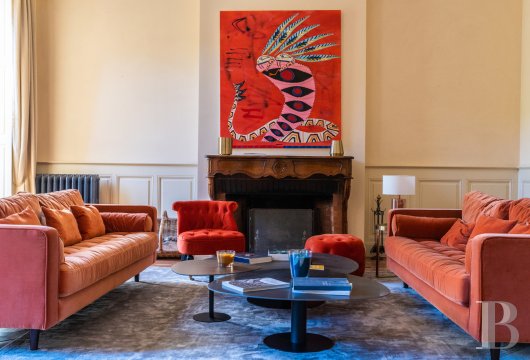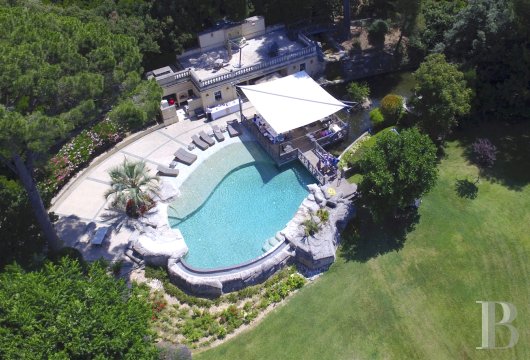Add to favorites
Log in to your personal space

The château's chef offers cookery workshops on request, which can take place indoors or outdoors.
The château offers artists' residencies to enable artists to bring their work to life, organise exhibitions, take part in organised or informal meetings, take part in discussions with professionals and collectors, and to engage in dialogue with their potential public, who can also discover their work during open days and studio visits.
As the Phocaean city fades into the background, leaving nature to reclaim itself as far as the calanques, the patrician silhouette of the mansion rises out of the heart of a lush parkland that shelters it from view. The very last dwelling before the Mediterranean, where the footpaths lead to the coast in a series of twists and turns through the garrigue, this lookout point is now reserved for holidaymakers, event organisers and art exhibitors, and gives the impression of having been miraculously saved from the all-consuming surrounding urbanisation. Completely renovated to the highest standards, Château de Forbin is an ideal stop-off point for those wishing to discover this Provencal land bathed in turquoise waters.
We acquired this property in 2019. The château's historic past and strategic location 15 minutes from Marseille's city centre were the driving forces behind our choices. On 25 June 2020, the château opened its doors to the public, hosting an artists' residency and an exhibition of our collection of New York post-graffiti from the 1980s and 1990s. Since the beginning of 2022, the venue and its gallery have been dedicated to holidaymakers and the organisation of private or professional events.

The 1 000 m2 historic residence is surrounded by a vast parkland, a legacy of the bastide estate of the past, which includes a waterfall, ponds, a greenhouse, an aviary and a formal French garden in its private section. The façade of the château is adorned with superb Renaissance windows. They were salvaged before the Forbin mansion was demolished when the Rue Impériale was built in 1864. Inside, a spiral staircase leading to the various floors is probably the work of Gustave Eiffel. There is a fragment of stone carved in the 5th or 6th century in the library. It comes from the Castrum Saint Marcel, a medieval castle whose remains have all but disappeared.

The Forbin family, an illustrious lineage linked to the kingdom of France, acquired a hunting lodge in the 15th century from the lords of Les Baux and turned it into an aristocratic residence. The current château, which has undergone many alterations, dates back to 1865. In 1482, Palamède de Forbin, consul and ambassador to the King, who was responsible for diplomatic negotiations, ensured that Provence became part of the French Crown. The king thanked him by appointing him as governor of Provence. Palamedes and his family inherited considerable power over a territory that included Aragon in Spain, Provence and the Dauphiné. It grew rich due to maritime trade, becoming one of the most powerful merchant families in Marseille. The Forbins were marquises, merchants, shipowners and bishops. They even included a marshal, a cardinal and five presidents of the Provence parliament!
We offer a unique setting in seven hectares of wooded parkland, with dedicated services throughout your stay, including housekeeping, cleaning, accompaniment and organisation of services and activities for our guests: boat trips in the calanques, bike rides, tailor-made visits to wine estates, meals with chefs and sommeliers, massages, yoga... A part of the parkland located further south, in the heart of the National Park, is open to visitors and allows them to admire the century-old Provencal cypresses and Atlas cedars, which reach a height of some 20 metres and which have witnessed a large part of the Forbin history.

The calanques of Marseille, Cassis and La Ciotat, Marseille's natural treasures, are little paradises preserved and left wild thanks to the close protection they receive. Take a lunch break at "Chez Tania" in Calanque de Figuerolles, for a timeless moment in good company. In Cassis, visit Clos Saint Magdeleine, a vineyard planted in the shelter of Cap Canaille, a 400-metre-high sea cliff plunging into the Mediterranean. Nestling in the Corton cove, facing Cap Canaille, “Villa Madie” with its three Michelin stars, majestically overlooks the sea. In Marseille, the three-Michelin-starred “Alexandre Mazzia”, a true artist and chef in perpetual motion, serves food in a chic residential area not far from the Velodrome stadium. In Aix-en-Provence, the Hôtel de Caumont hosts major temporary exhibitions dedicated to the great names in the history of art, from the 14th century to the present day.

 A link to enter a new password has been sent to you by email.
A link to enter a new password has been sent to you by email.
By continuing your navigation, you accept the use of cookies to offer you services and offers adapted to your centers of interest and to measure the frequentation of our services. Learn more